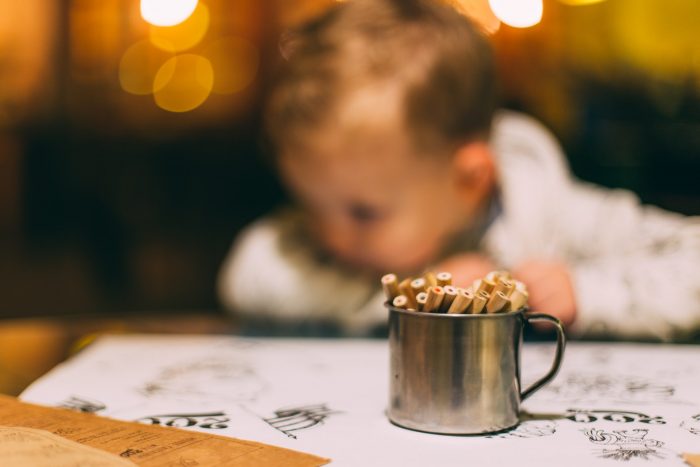As adults, when we smell crayons, magic happens within our minds. An entire universe of memories is unlocked as we sit quietly and color.
We all know the childhood nursery rhyme: “Sticks and stones can break my bones but words can never hurt me.” Bullsh*t—words do hurt. I was in first grade when I learned a painful, but valuable, lesson on the importance of ill-spoken words and the effects they have on our perception of not only ourselves but the world we live in.
My first-grade classroom was at the back corner of the old stone building. Two of the walls were filled with tall windows that looked out onto our playground. Most days I didn’t pay attention to the teacher. I was too busy staring out of the windows, dreaming of how I would save my classmates from the monsters I knew were hiding in the brushes just over the bridge from the playground.
But, not today. No, today I was going to be a famous artist.
As I sat, wiggling in my chair, my teacher, Mrs. W., walked around the room giving us clear instructions on how to carefully color the pear outline she placed on our desks. Without any hesitation, I picked up my crayon and began to give life to the pear I clearly saw in my mind.
It did not take me long to finish my artwork, and I could not wait to show Mrs. W. So, I proudly marched up to her desk, and with a grin from ear to ear, I handed her my magnificent masterpiece. Mrs. W. stared at the piece of paper and then stood up for what I assumed to be a world-class speech on how impressed she was with my artistic abilities at such a young age.
I stood at the front of the room, facing my classmates while waiting to hear her encouraging words. But, instead, I heard Mrs. W. asking why I had not colored my pear. Completely confused, I pointed to the paper and said: “I did—I colored it white.”
Her face scrunched up tightly, and she sternly said: “Pears are not white.” I did not understand why she could not see my glossy white pear, so I pointed to the piece of paper and quickly replied: “Look at the pretty pear.”
What happened next damaged my little six-year-old self-esteem and planted the seed for not only a rebellious teenager to grow, but also a lifelong fear of trust issues well into my adulthood.
Mrs. W. picked up a red pen from her desk, and to my horror, drew a huge letter F across my beautiful, shiny-white pear. If that were not enough to destroy my confidence, she added to my humiliation by telling me to sit down and saying she would be speaking to my parents about my behavior of failing to follow rules.
And then, in horror, I stood at my desk and watched as she held up my artwork for the entire class to see, and mockingly asked: “Are pears white, class?”
My little heart was beating so fast as I sank down in my chair and fought back tears as the students started laughing at me. My friend sitting next to me learned over and asked: “Why did you color the pear white? Now you are in trouble.”
In trouble?—I thought. I saw a glorious, shiny white pear. What did I do wrong?
On that day, an adult had the power to flame a child’s imagination, but instead chose a different path—one that taught me it was not safe to express myself freely because I would be laughed at.
Childhood trauma can take many forms—from a seemingly simple little comment to horrific acts of violence. However small or large they may be, the events penetrate deep into our subconscious mind and change the way we interpret the world around us.
But, I’m an adult now—shouldn’t I be over that?
I read the other day about a successful man who had a fear of speaking in front of others and did not understand why. Through counseling, he learned that when he was three years old, he was told by a stranger that he talked too much. This stranger said: “If I had a child who talked that much I would drown them like a cat in the lake.”
Subconsciously, his mind had taught him to keep quiet to stay safe. Out of fear, he held onto this day well into his adult life. Whether we remember the words spoken to us as children or not, our mind keeps score to protected us from danger.
Growing up, I tried my best to fit in with everyone else, but my imagination and love for colors just kept calling to me. And because I was not truly living an authentic life for a long time, I was angry and didn’t understand why I was so afraid to try new things.
When hurtful words are spoken to young children, their minds learn to associate any situation similar to the hurtful event as a dangerous one.
Over time, we may think we have forgotten what happened to us. But we have just learned to cope by disassociating from the event that harmed us, but our mind never forgets.
We all have memories we hide from, but to live a full life we must embrace not only the good, but the bad memories. When we remember hurtful situations that happened to us as children, we can go back to that hurtful memory and see it from a fresh perspective as an adult and possibly make sense of the situation or at least make peace with it.
That’s why a box of crayons is, sometimes, the best therapy.
I’m not knocking therapy from a licensed professional, but sometimes we do not even know what is wrong. Why are we so afraid to fly on a plane or receive feedback from our boss? Or why do we shut down emotionally when a relationship is going great?
The first step in starting anything in life is the most difficult one. And when we do not even know where to start, we may think the task at hand is too difficult to reach, or we may stand frozen in place, filled with doubt.
Start small. I have always loved to draw and paint, and I’ve been taking a lot of art classes this summer. Possibly this is why I woke up remembering the events of my first-grade day so vividly.
We can think back to when we were small—what did we enjoy doing for fun? Do not overcomplicate this process. Just sit quietly and think of the childhood things we did that brought joy to our lives—or just grab a box of crayons.
There is something about the smell of crayons that fills my mind with childhood memories.
Sit quietly on the floor or at a table and just color, paint, play with playdough, or do anything that fills our minds with memories of our childhood. Allow the thoughts to come and go. We must give ourselves time to do this exercise—engaging in play time in a nonjudgemental way to freely express our creative side.
Grab a recorder or a pen and paper. Be patient. It may take a few times before the memories start flooding our minds, but as they begin, we can write or record the thoughts as they enter our mind in as much detail as we can see them. Some thoughts may be well-known—but as we reconnect with our childhood memories, long-forgotten memories may surface.
Not all memories will be negative. Embrace the positive thoughts and write about them as well. My memory of first-grade was not all bad thoughts. I was able to remember how vivid my imagination was and how much I loved recess. I had warm thoughts of friends I have not thought of in a long time. I was able to reflect on the words I have spoken to others and forgive myself for any harsh words I have said.
Processing our memories.
It may seem silly, but we must sit down with our inner child, extend our hand, and have a heart-to-heart conversation. As we remember different events, we must observe our feelings, process the emotions, and allow ourselves time to heal and feel safe.
Next, we must go back to our written words and read them again after we have processed the memories and feel safe. Now re-write the events from a point of healing. We want to remember the events as children, but we must process them as adults to heal.
When I re-read my journal entry on the events that happened so long ago, I was able to heal an old wound. I went back in my stored memories as an adult and observed my feelings. I then forgave the words spoken by my teacher and told myself I was proud of my artwork.
The feeling of embarrassment helped me to understand why I get so nervous when trying new things.
“Healing doesn’t mean the damage never existed. It means the damage no longer controls your life.” ~ Akshay Dubey
If we uncover things we cannot resolve, we can process the memories at a deeper level with the guidance of a trained professional. If we have childhood trauma, I highly recommend Eye Movement Desensitization and Reprocessing (EMDR) or Brainspotting.
Brainspotting and EMDR are forms of psychotherapy that use our field of vision to access deeply embedded traumas not only within our minds but stored in our bodies.
“Where you look affects how you will feel.” ~ David Grand
Our past does influence us and words do hurt. But the past is not who we are, and we can heal from hurtful words stored in our minds. Sometimes, we just need to be kids again and embrace our past, meet the pain with vulnerability, forgive the offense that hurt us, and tell a new story—an authentic narrative where we are the masters of the story we tell.
One where a pear can be colored white.
~
 Share on bsky
Share on bsky






Read 13 comments and reply